Tackling covid
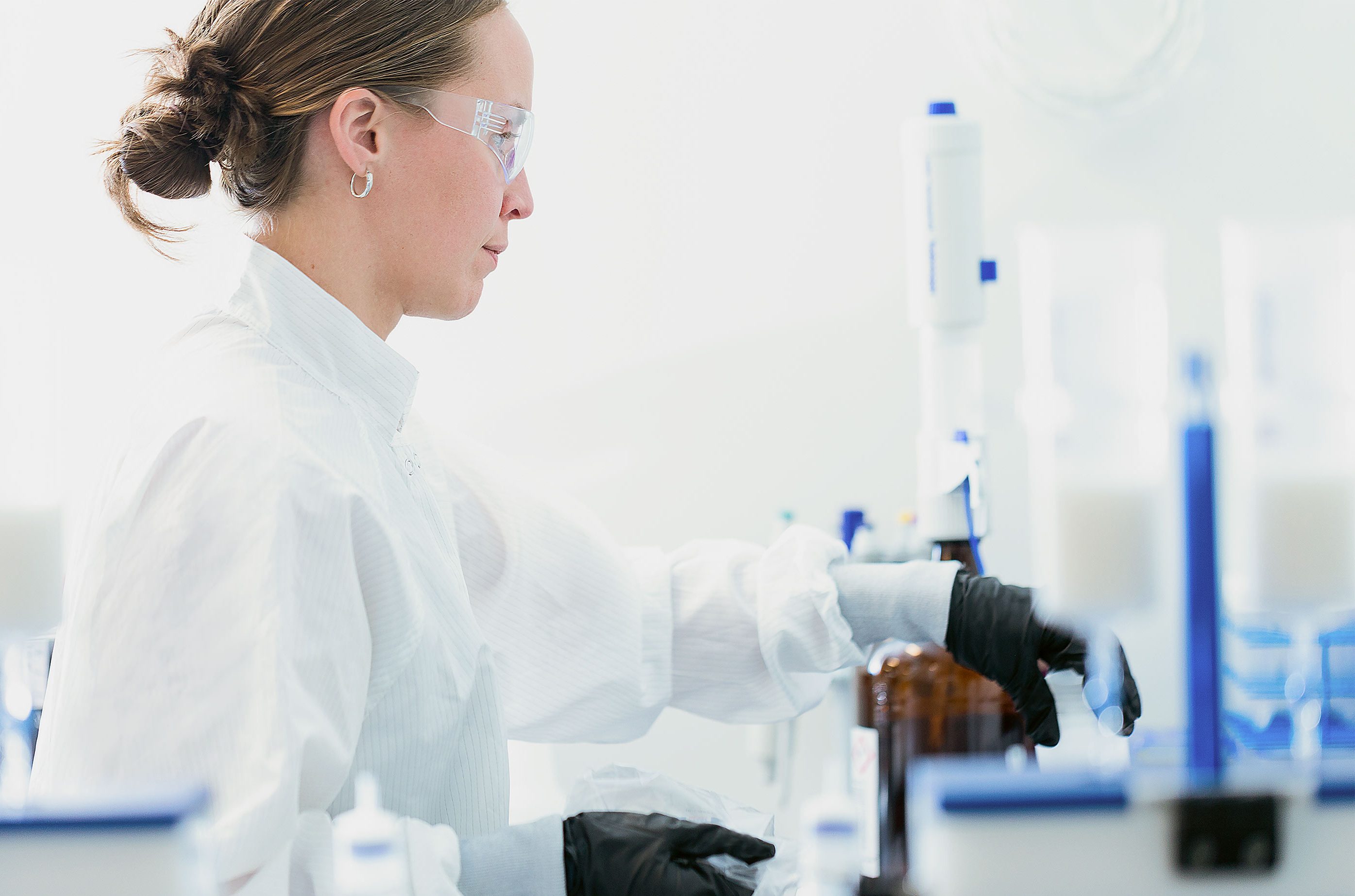
As covid-19 spread across the globe, killing hundreds of thousands and wreaking economic havoc, the MIT community took on some of the biggest questions we faced: Why can’t we test at scale? Where will the next outbreak be? How can we keep doctors and patients safe at the same time? And when will we finally have a vaccine? From the earliest days of the crisis, the Institute’s alumni, labs, and companies have been reworking their research and inventions to meet these pressing challenges. Here we report on five of their many bold attempts—and how things are going so far.
THE CHALLENGE:
People don’t have immunity to the new coronavirus.
THE PLAN:
Moderna is trying to develop a vaccine in record time.
The scientists at Moderna, a Cambridge-based biotechnology firm that includes about two dozen MIT alumni, are working day and night to develop a vaccine. It’s a big swing: if their candidate succeeds, it will be the first vaccine of its type to be approved, as well as the first the company has ever brought to market.
Vaccines spur the body to mount an immune response against a bacterium or virus. Most vaccine development labs “grow viruses up, and then inactivate them or attenuate them,” says Robert Langer, ScD ’74, an Institute Professor and Moderna’s academic cofounder. The vaccine then ferries the defanged germ into the body. Other vaccines bring in a unique, representative piece of the virus—a protein or a polysaccharide—that isn’t harmful, but still inspires the proper immune response.
Moderna takes a different approach: its vaccines carry strands of messenger RNA that code for one of those harmless representative proteins. Human cells then read the mRNA, create the protein themselves, and mount the response. “The body is the factory,” Langer says.
It took years for Moderna’s scientists to create a mechanism to deliver this genetic material effectively into human cells. But by swapping in different mRNA strands, Moderna can now “very rapidly identify, make, and test” vaccine candidates, says cofounder and chairman Noubar Afeyan, PhD ’87. Being able to quickly respond to a situation like covid-19 was “the vision when we started,” Langer adds: they put the time into developing the vaccine platform “so that if something ever happened, we were really ready to move forward.”
That speed has been on public display since late February, when the company sent a batch of its vaccine to the National Institutes of Health. It had taken the researchers just six weeks to look at the virus’s genetic code, choose a protein to focus on (they picked the spike protein, which helps the virus get into cells and is responsible for its crownlike appearance), and create a prototype. Lab trials, animal trials, and other steps that normally happen in sequence were performed all at once, even though a bad result for any one of them could have meant completely starting over.
It paid off. On February 21, the vaccine passed the final hurdle of the development stage: the sterility test, which ensures that it’s free from microbial contamination. Approval from the Food and Drug Administration to proceed with testing quickly followed. By March 16, 45 volunteers were rolling up their sleeves to participate in a phase I clinical trial, meant to establish whether the vaccine is safe.
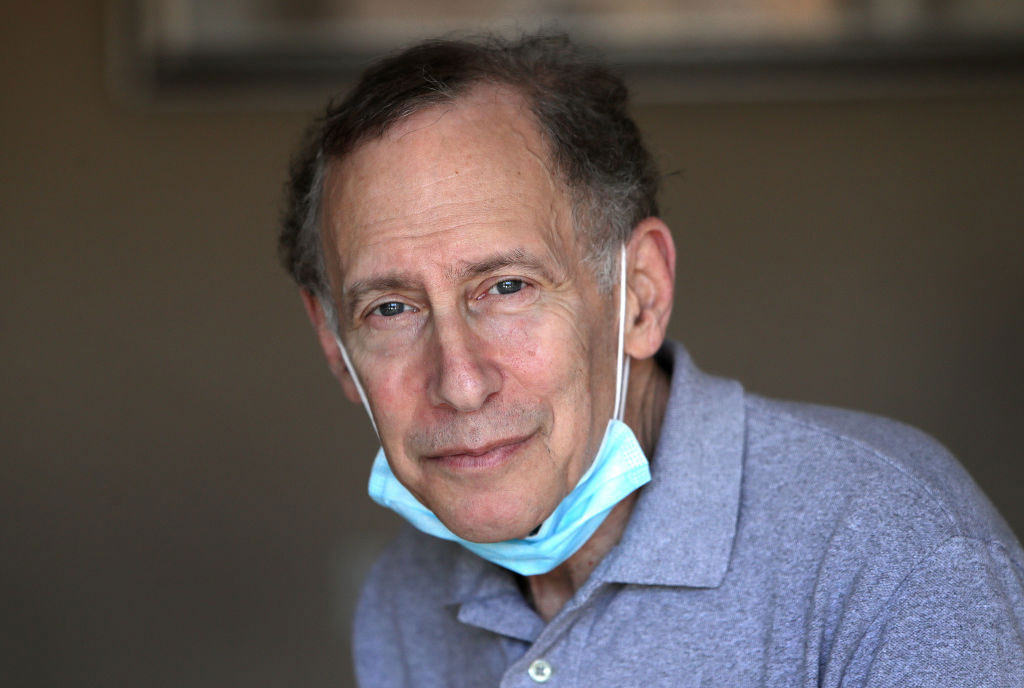

That first trial yielded promising interim results, later confirmed by a peer-reviewed study: all recipients created antibodies to the virus, and only a few reported severe side effects, none life-threatening. So on May 29, Moderna kicked off a phase II trial with 600 participants to dig into the vaccine’s biological effects and efficacy and pin down the ideal dose. A phase III trial with 30,000 people was expected to begin in late July.
During the phase III trial, half the volunteers receive the vaccine, while the others get a placebo. If members of the placebo group contract covid-19 and members of the vaccinated group don’t, that indicates success. Because people are taking precautions to stay healthy, results could take months to arrive. But if they’re encouraging, the FDA may grant the vaccine an emergency-use authorization, which would allow it to be administered to especially vulnerable populations, perhaps by the end of the year. (The FDA indicated at the end of June that it plans to follow its usual vaccine approval process.)
Although the vaccine has not yet been approved, “we are investing quite a bit in establishing large-scale production,” Afeyan says. In mid-April—before the phase II trial had started—Moderna secured funding to accelerate its buildup of inventory. In late June, it announced a “fill-finish” collaboration with Catalent, a pharmaceutical company that will bottle, cap, and label the vaccine.
The idea is to get about 100 million doses ready, so that if and when the go-ahead arrives, they can be shipped out right away. Moderna says it’s on track to produce 500 million doses—or possibly up to a billion—in 2021. Others working on their own vaccine candidates, such as J. Christopher Love’s Lab at MIT’s Koch Institute, are also thinking about scalability. “This is a race where I hope we have multiple winners, because we’ll need them,” says Langer.
It’s a massive undertaking, full of uncertainties. “No pharmaceutical company has invented a molecule, tested it in humans, and gotten it to mass reach within five years, let alone within 12 months,” Afeyan says. “Every step along the way is completely uncharted territory.” This is especially true for Moderna, a company that has never before brought a vaccine to market. It’s now among those leading the charge to develop the most important one in a generation—testing out relatively new technologies in an unprecedented time, under a glaring global spotlight.
But being daunted by the challenge is not an option. “We can’t think of a better alternative than to try,” Afeyan says.
THE CHALLENGE:
People can’t get tested easily for covid-19.
THE PLAN:
E25Bio is making a diagnostic that’s as simple to use as a pregnancy test.
At the beginning of the pandemic, tests were unavailable, error prone, or simply ineffective. Those who did manage to get a test often had to wait days or weeks for the result. Months in, testing is still difficult and often expensive, and it usually requires trained medical professionals.
To Lee Gehrke, the Hermann von Helmholtz Professor of Health Sciences and Technology at MIT’s Institute for Medical Engineering and Science, these problems were familiar. Gehrke is a cofounder of E25Bio, a biotech startup that is trying to develop “inexpensive, accurate, easy-to-use diagnostics” for viruses, he says. As of mid-July, the company was awaiting FDA authorization for its covid-19 test, which can be mass-produced, requires no sample processing, and gives a readout within 15 minutes. (E25Bio is supported by The Engine, MIT’s venture fund for “tough tech” startups.)
E25Bio grew out of work done in Gehrke’s lab by Irene Bosch, a Broad Institute researcher who joined Gehrke’s lab as a research scientist in 2009 and is the company’s CTO. Their aim was to develop rapid tests for mosquito-borne diseases, like Zika and dengue fever, where an early diagnosis can be critical. “Then covid hit,” says Gehrke. Bosch quickly realized they could apply their existing technology to this new threat.
E25Bio’s paper-based test doesn’t require electrical power, refrigeration, hard-to-obtain chemicals, or special expertise.
As of July, all available covid-19 tests required samples to be shipped to a lab or run through a machine. But because E25Bio researchers created their platform specifically for communities with limited access to health care, it’s more straightforward. The diagnostic is a paper strip painted with pathogen-specific antibodies and gold nanoparticles, which become visible when the antibodies bind to the targeted virus.
“It looks a lot like a pregnancy test,” says Gehrke. To use it, you apply a fluid sample to the strip and wait for the appearance of either one stripe (for a negative result) or two (for a positive). There’s no need for electrical power, refrigeration, hard-to-obtain chemicals, or special expertise, he says. The company is looking at its efficacy with samples of both nasopharyngeal fluid, which requires a long swab up the nose, and easier-to-obtain saliva.
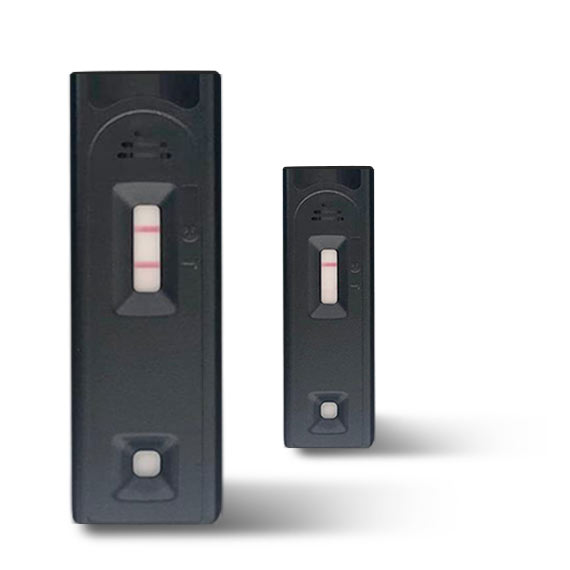
The E25Bio covid-19 test provides results within 15 minutes: one stripe, negative;
two stripes, positive.
Other companies and research teams associated with MIT are also developing simple tests. Scientists from the McGovern Institute for Brain Research, the Broad Institute, the Ragon Institute, and the Howard Hughes Medical Institute are working on a CRISPR-based diagnostic that can deliver results in less than an hour and might be used at home or in a clinic. And collaborators from MIT, Nanyang Technical University, and the Singapore-MIT Alliance for Research and Testing are working on a rapid paper-based test as well.
It’s easy to imagine the benefits of an option that is quick, easy, inexpensive, and low-tech. Students and workers with no symptoms might start swabbing their noses or tongues every few days to make sure they haven’t been exposed. Symptomatic people without ready access to doctors could also test themselves.
E25Bio has applied for an emergency-use authorization from the FDA, and its test underwent clinical trials in several hospitals over the spring and summer. But as of mid-July there were still some hurdles to clear. For one thing, the test needs to be validated on samples from patients who have actually tested positive for covid-19. As case numbers dropped, it became harder to find these patients, Gehrke says, and the approval process required to obtain the samples is complex.
Meanwhile, E25Bio has lined up suppliers and a manufacturer so that if the test tests well, the company can hit the ground running. If there’s one thing that’s certain about the pandemic, Gehrke says, it’s that “we’re going to have to do a lot of testing.”
THE CHALLENGE:
It’s difficult to monitor coronavirus outbreaks.
THE PLAN:
Biobot is tracking community infection rates via wastewater.
To properly respond to the coronavirus, communities need a lot of information: where the infection level is at a given moment, whether it’s rising or falling, and how it’s been affected by policy decisions about what is open and who can go where.
Widespread individual testing would help with this—but we can’t be sure there will be enough tests, or that people will be willing to take them regularly. So Biobot Analytics, a Somerville-based startup that specializes in wastewater-based epidemiology, is sleuthing out answers in existing infrastructure: the sewers.
Wastewater contains plenty of information about a community’s inhabitants: evidence of everything from sleep and stress levels to pathogens, opioids, and dietary preferences, says Mariana Matus, PhD ’18, cofounder and CEO of Biobot, which is also backed by The Engine. These markers can be sussed out using well-known techniques, like DNA sequencing and mass spectrometry.
“It’s very common to apply [these techniques] to patient samples or experimental samples, but not really to wastewater samples,” says Matus, who cofounded the company in 2017 with Newsha Gaeli, formerly a research fellow in MIT’s Senseable City Lab. So where others see a waste product, Biobot sees “an untapped source of public health insights.”
In February, researchers announced that the coronavirus could be found in human stool. Around the same time, it became clear that widespread testing was far off. “We realized it was really an opportunity for us to use our expertise to make a difference,” Matus says.
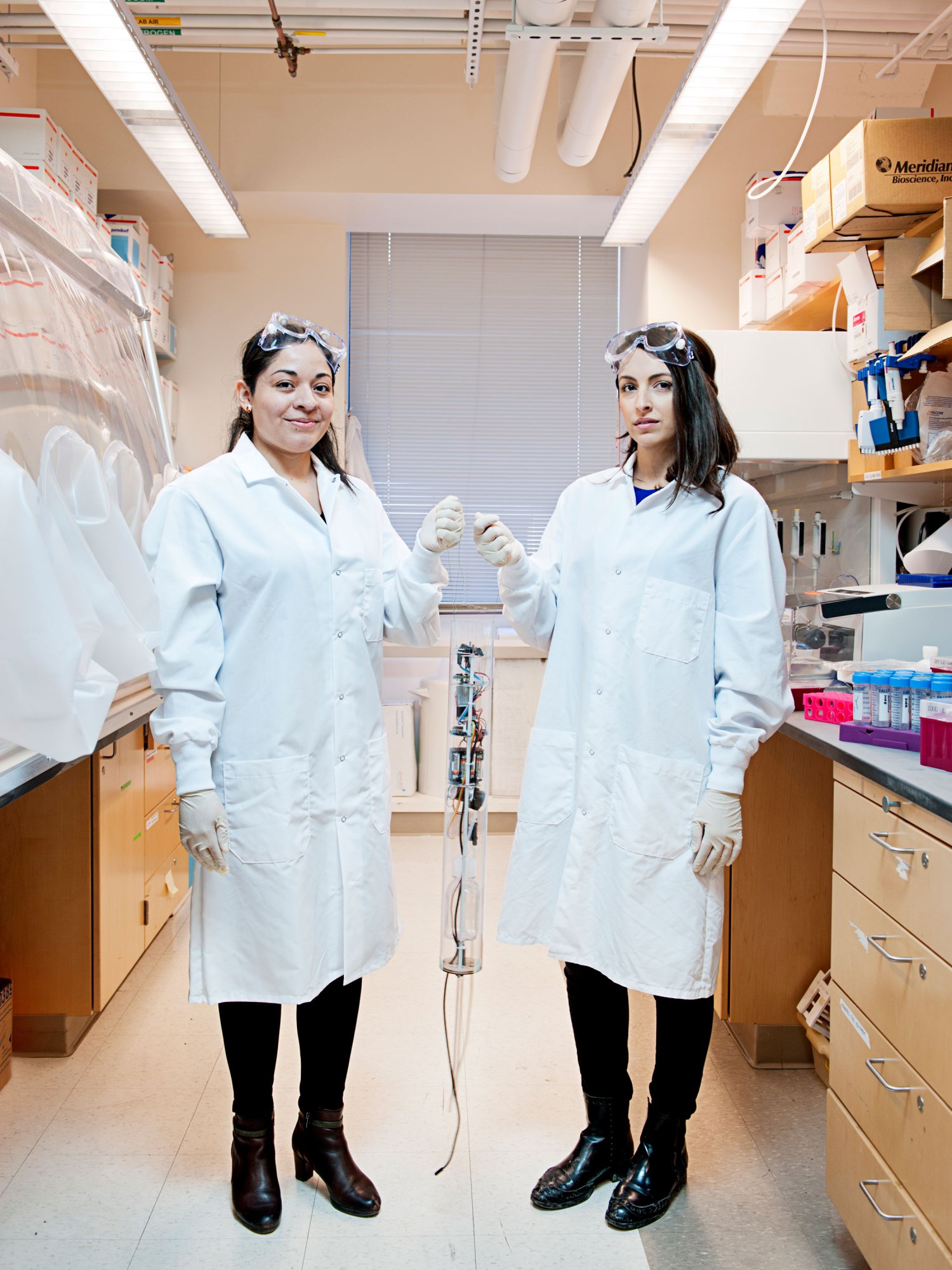
Biobot cofounders Mariana Matus, PhD ’18 (left), and Newsha Ghaeli with the robot they designed to collect wastewater samples.
In late March, Biobot put out a call for sewage samples. Within a few days, hundreds of responses came in from across the country. Each week from March 23 through the end of May, the company processed samples for free from 400 communities in 42 states—wastewater that represented about 10% of the total US population, Matus says. It has since moved to a paid model and is currently working with about 100 cities, from Fort Bragg, California, to Chattanooga, Tennessee.
So far, Biobot’s research suggests that wastewater can indeed paint a picture of an outbreak’s progression. Using a bank of samples from a treatment plant in Massachusetts, the company found that the virus showed up in the sewers in early March—around the same time as the first confirmed case. The amount then grew exponentially, Matus says—until the weeks after the shelter-in-place policy was announced, when “we started seeing a leveling off, or even a small decrease.”
Overall, the viral load in wastewater correlated with the number of cases found through clinical testing—but trends appeared about four days earlier in the wastewater, according to a preprint Biobot published prior to peer review on medRXiv in late June. This supports the theory that individuals shed virus most heavily (and are therefore likely most contagious) before their symptoms appear. It also suggests that wastewater testing could pinpoint emerging outbreaks days earlier than other methods.
As officials make difficult calls about when to lift—or reapply—restrictions, it will help to have “a pulse of the level of infection in a community, in real time,” says Matus—like the one thrumming under our feet.
THE CHALLENGE:
Poor communities don’t have what they need to respond to the pandemic.
THE PLAN:
The Virtue Foundation and the Okoa Project are using data maps to efficiently distribute oxygen cylinders, handwashing stations, and other vital tools in northwest Ghana.
To effectively manage the pandemic response, public health professionals need to know where resources such as ventilators, oxygen delivery supplies, and masks are—and where they aren’t.
Joan LaRovere, MBA ’16, is a pediatric cardiac intensive care physician and a cofounder of the Virtue Foundation, a nonprofit that focuses on health care and education. In 2010, the foundation—which regularly sends medical teams to Ghana, Cambodia, and Mongolia, among other countries—began asking its doctors to gather information about things like hospital access in the communities they visit. It went on to build a data-mining and analytics team and began producing smart data maps to help nonprofits, governments, and local public health professionals understand where the resource gaps are and how they might be filled.
When the pandemic started, the Virtue Foundation released a map of health-care facilities in 25 low-income countries. In areas where its teams had already spent a lot of time, the foundation had even more information and was itself well-positioned to help. One of those places was the Sissala East municipality of northwest Ghana, where it has previously focused on maternal and infant mortality. “We had this granular map of what the community health situation looks like: where the health centers are, what the roads are like, what their capacity is,” says LaRovere.
It also had a willing partner in the Okoa Project, a nonprofit begun at MIT’s D-Lab that helps communities design, build, and distribute health-care-related technologies. Shortly before the pandemic began, the Okoa Project had expanded to Sissala East, where it had hired a team of local engineers and begun building ambulance trailers configured to attach to motorbikes.
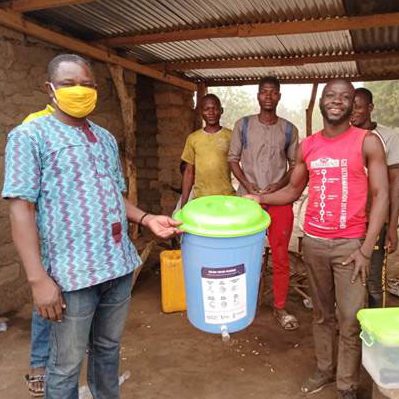
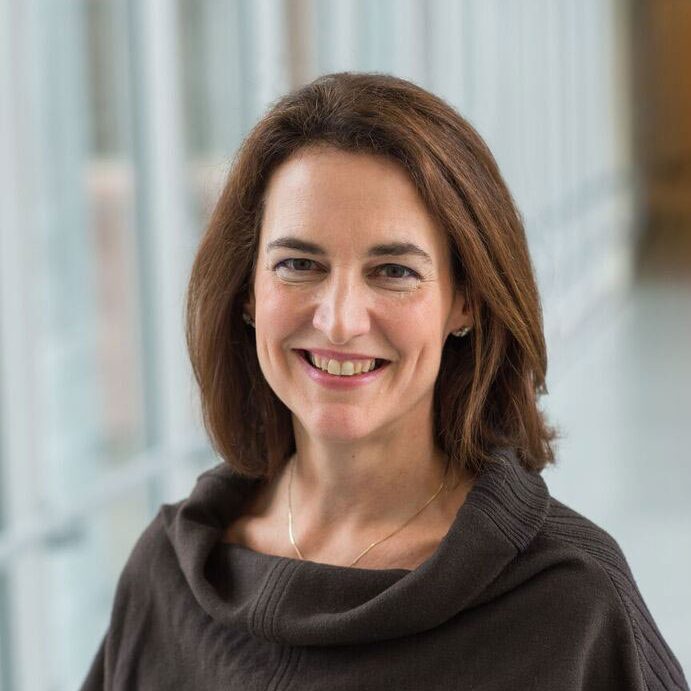
While ambulances are useful in a pandemic, “we realized there was the option to help with preventive measures,” says Emily Young ’18, the organization’s cofounder and executive director. Nana Damoah, the group’s Ghana country director, floated the idea of building “Veronica buckets.” Invented by Ghanaian biologist Veronica Bekoe, they’re portable hygiene setups: a plastic cask of water with a tap, perched on a stand and flanked by a container of liquid soap. A basin placed below catches runoff.
“Our technicians, who normally make ambulances, started to make these handwashing stations,” says Young. In two weeks, they made 600 buckets. Using Virtue Foundation maps to figure out where they were most needed, they stationed the buckets around 62 Sissala East communities, along with locally made soap.
Meanwhile, the Virtue Foundation worked with local health services to strategically distribute ventilators, oxygen cylinders, personal protective equipment, and other supplies to the region’s hospitals and clinics. It also commissioned and bought 500 face masks from local seamstresses to distribute to health centers and community members, and repaired a radio transmitter so it could be used to broadcast public health directives. LaRovere spent a lot of time on WhatsApp, telling clinicians in Ghana what she was learning from fighting the disease in America.
As of mid-July, there were relatively few cases in the region, suggesting that the data maps—and the steps based on them—have made a difference. “We saw the potential of it, and now we’ve seen it in action,” says LaRovere. “If you use smart data, you can help flatten the curve before it gets there.”
THE CHALLENGE:
We don’t know much about the progression of covid-19, and it’s dangerous to treat.
THE PLAN:
Emerald uses electromagnetic waves to track patients’ vitals from afar.
Health-care workers on the front lines of the pandemic must try to provide care without risking their own health, minimizing time and contact with the very patients they’re trying to treat—and learn from.
Doctors at some Massachusetts assisted living facilities are getting help from Emerald, a device that uses electromagnetic waves and artificial intelligence to monitor patients remotely. From a corner of the room, or even the other side of a wall, Emerald can track a patient’s breathing, heartbeat, mobility, and other health markers. It’s unobtrusive and low-effort—“like a Wi-Fi box, but smarter,” says its creator, Dina Katabi, the Andrew and Erna Viterbi Professor of Electrical Engineering and Computer Science at MIT.
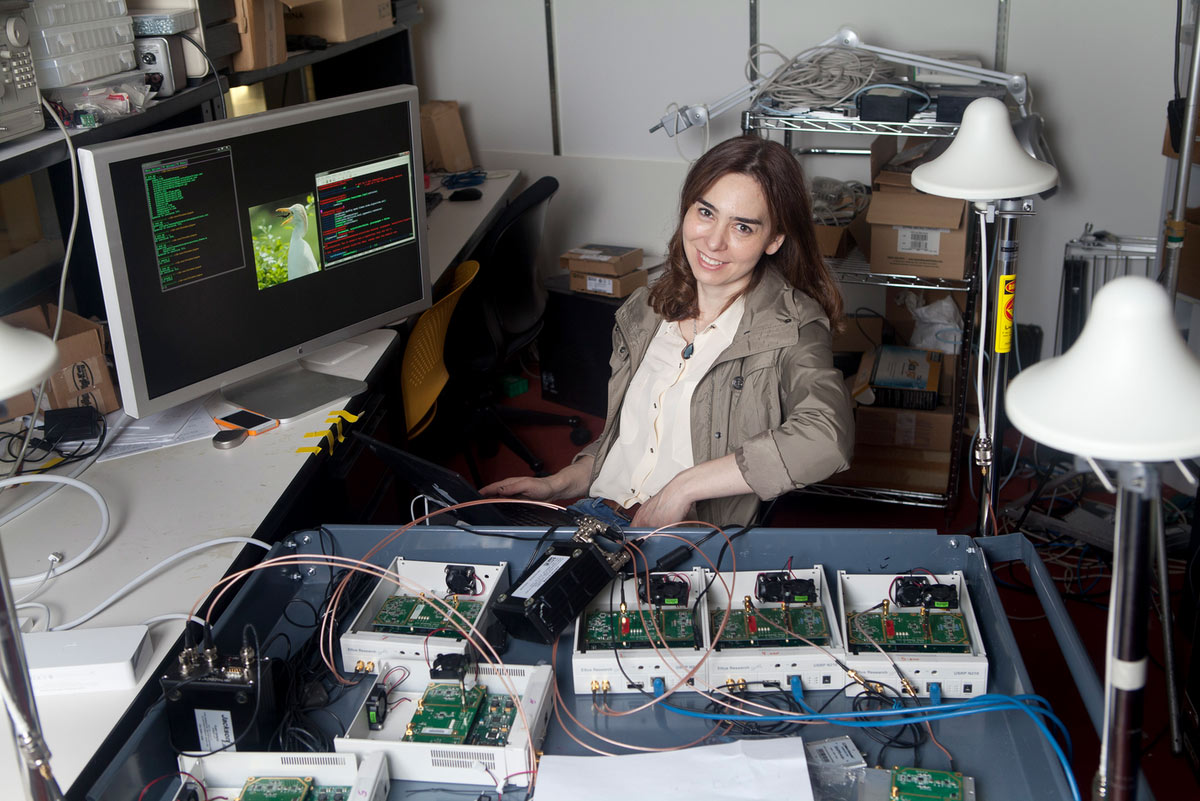
Designed to collect consistent, sustained data, Emerald has been used in long-term studies of diseases like Parkinson’s, Alzheimer’s, and epilepsy. When the communities where the platform is normally used—in retirement and assisted living homes—became some of the hardest hit by the pandemic, another of its strengths became clear. Emerald “allows a caregiver to capture the physiological signal of a patient without the caregiver being close to the patient,” says Katabi, who founded a startup company based on the technology in 2013.
Ipsit Vahia, the medical director of the Institute for Technology and Psychiatry at McLean Hospital, had already been working with the devices to study the effects of dementia. In April, he began using them to help him care for four patients recovering from covid-19 in an assisted living facility—without setting foot in their rooms. An abnormal breathing pattern might be a sign of respiratory distress, while pacing could indicate anxiety.
By tracking both physical and mental health markers, Emerald offers a unique window into the illness.
By tracking both physical and mental health markers, and focusing on patients who aren’t in critical condition, Emerald “is giving us a window into the illness that not a lot of people are looking at,” says Vahia, who uses information gleaned through Emerald to supplement what he learns during telemedicine visits.
Vahia plans to employ the technology to care for more covid patients, for whom recovery can be long; at least 20 will be involved in one upcoming study. And as of mid-June, clinical teams at McLean, the Mayo Clinic, and Washington University Medical Campus in St. Louis had adopted the tool for covid care as well.
Emerald was not originally designed for real-time use. So Katabi’s team and the caretaking staff spend a lot of time communicating, swapping feedback and providing advice. In the first weeks of the pandemic, they met each evening over video chat to talk through the data from that day. Now they convene a call whenever a new data set or observation merits it.
Although they are working on automating this process further so that they can scale it, the back-and-forth has been invaluable as the team revamps the device for this new purpose, Katabi says: “We are in continuous contact.” At a distance, of course.
Keep Reading
Most Popular
Large language models can do jaw-dropping things. But nobody knows exactly why.
And that's a problem. Figuring it out is one of the biggest scientific puzzles of our time and a crucial step towards controlling more powerful future models.
How scientists traced a mysterious covid case back to six toilets
When wastewater surveillance turns into a hunt for a single infected individual, the ethics get tricky.
The problem with plug-in hybrids? Their drivers.
Plug-in hybrids are often sold as a transition to EVs, but new data from Europe shows we’re still underestimating the emissions they produce.
Google DeepMind’s new generative model makes Super Mario–like games from scratch
Genie learns how to control games by watching hours and hours of video. It could help train next-gen robots too.
Stay connected
Get the latest updates from
MIT Technology Review
Discover special offers, top stories, upcoming events, and more.